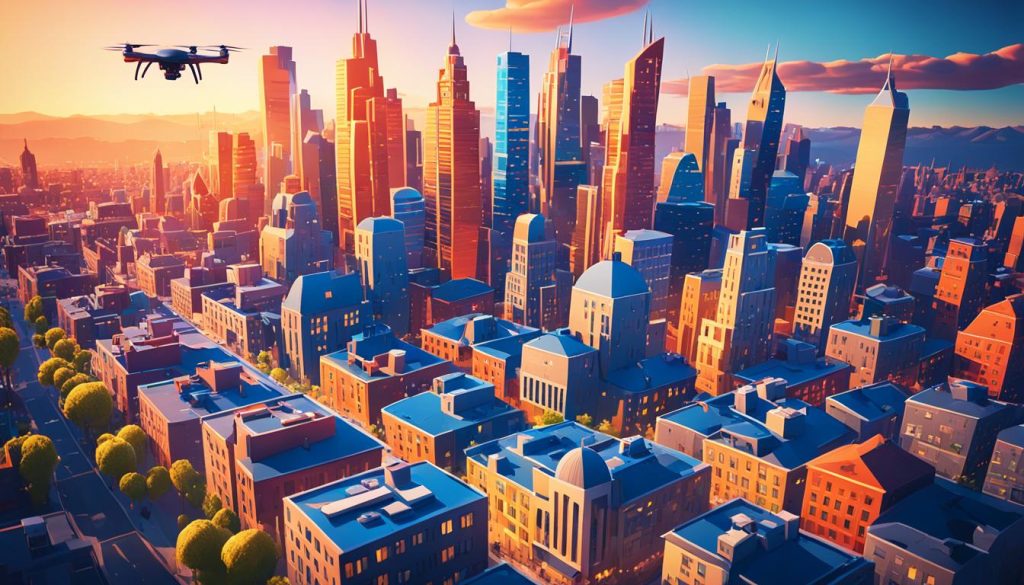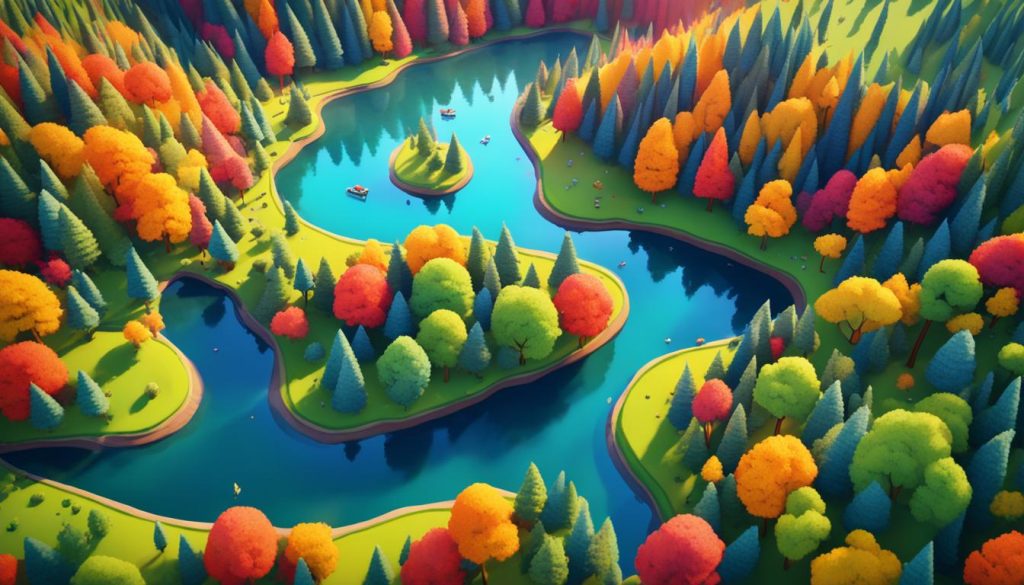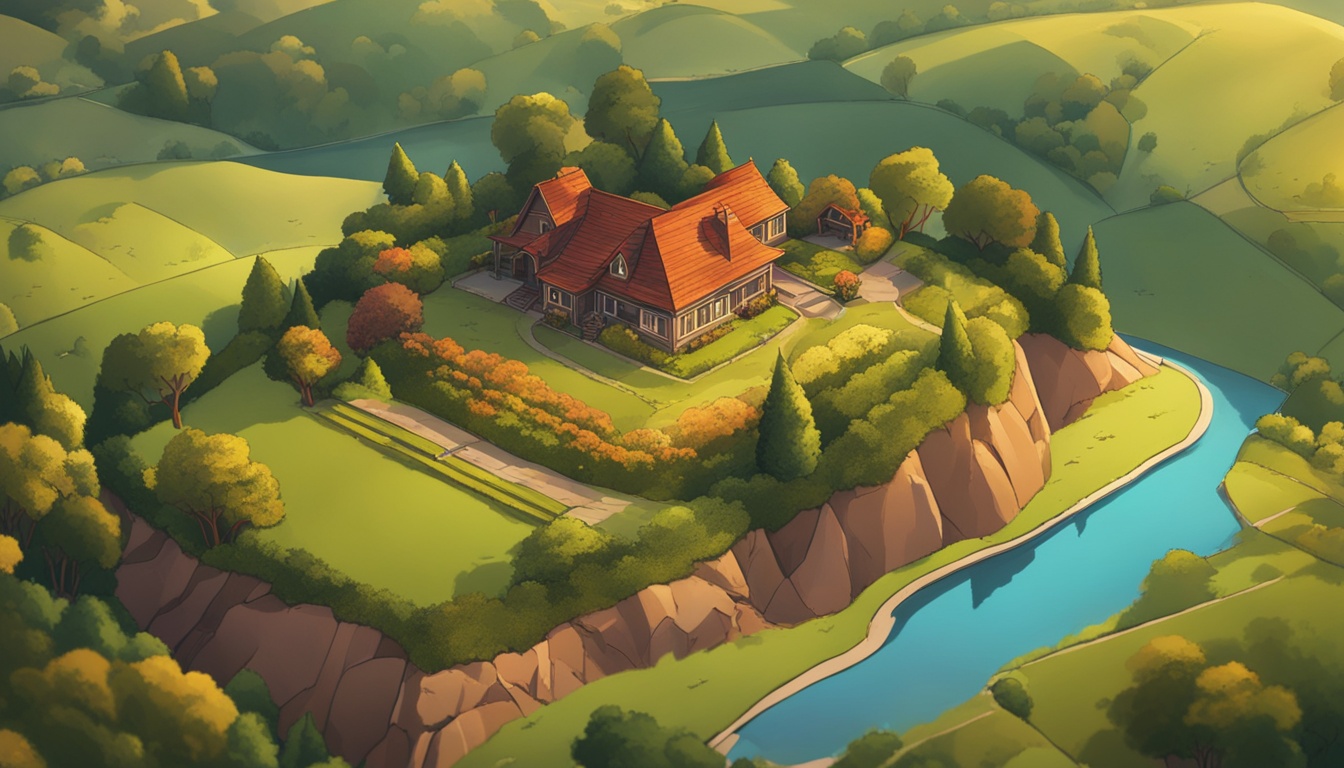AI color grading can turn your drone footage into stunning movies. This tech makes color correction automatic. It helps you get pro-looking results fast and easy.
It looks at your drone videos and tweaks colors, contrast, and mood. This makes your videos more appealing. Using AI for color correction saves time and gives you amazing visuals that grab attention.
To start with AI color grading for your drone videos, pick the right software. Get your footage ready and learn to use AI presets. With time, you can adjust these AI tips and make your own style for aerial videos.
Understanding AI Color Grading for Drone Footage
AI color grading is changing the game for drone cinematography. It turns raw footage from the sky into beautiful movies. Let’s dive into how AI makes your drone videos look amazing.
What is AI color grading?
AI color grading uses machine learning to tweak colors in your drone videos. It makes professional color schemes automatically, based on your reference images. This tech makes editing videos faster, saving time and keeping your footage looking consistent.
Benefits of AI color grading for drone videos
AI color grading brings big benefits to drone filming:
- Time-saving: Quickly apply complex color grades to entire video sequences
- Consistency: Keep a uniform look across all shots and lighting
- Professional results: Get movie-quality colors with little effort
- Creative freedom: Try out different styles with AI presets
How AI enhances aerial videography
AI is taking aerial filming to new levels with its color science and film tools. It looks at your footage and suggests the best color changes for stunning visuals. With AI, you can create unique looks, match colors between shots, and change lighting conditions. This tech lets videographers make top-notch aerial videos easily, without needing color grading skills.
Preparing Your Drone Footage for AI Color Grading
Before you start with dynamic drone video color grading, you must prepare your footage. This step is key for amazing results. First, go through your raw footage and pick the best shots for your project.
Then, bring your selected clips into your favorite editing software. Adobe Premiere Pro, DaVinci Resolve, and Final Cut Pro are great choices. They have powerful tools for making initial changes.
Start with basic color correction to fix exposure problems. Adjust brightness, contrast, and shadows for a balanced look. Be careful with highlights, as bright skies can easily get overexposed in drone footage.
White balance is crucial for true colors. Use the white balance tool to remove color casts. This is very important for drone footage, as it can be affected by the atmosphere.
Next, tweak your footage by adjusting saturation and vibrance. But don’t overdo it, as it can look fake. Aim for colors that are rich and real, perfect for AI color grading.
Finally, reduce noise if your footage is grainy. Drone cameras can catch grain in low light. Less noise means cleaner images for AI color grading.
- Review and select best footage
- Import into editing software
- Correct exposure and balance
- Adjust white balance
- Fine-tune saturation and vibrance
- Apply noise reduction if needed
By following these steps, you’ll get your drone footage ready for AI-assisted color grading. This preparation makes sure your footage is perfect for the dynamic and cinematic enhancements AI tools offer.
Choosing the Right AI Color Grading Tool
Finding the right AI color grading tool is key for making your drone footage look amazing. The best software can turn your aerial shots into stunning movies. Let’s look at some top choices and what to consider.
Popular AI-powered video editing software
Match AI and Color.io App are two top picks for AI video editing. Match AI is great for fast color matching. Color.io App has more features, like RAW processing and advanced color science.
Features to look for in AI color grading tools
When picking an AI color grading tool, focus on these features:
- AI image matching for consistent colors across shots
- RAW processing capabilities for maximum quality
- Film grain and halation effects for a cinematic look
- LUT and Lightroom profile generation for versatile output
Comparing AI color grading solutions
Think about these points when comparing AI color grading tools:
| Feature | Match AI | Color.io App |
|---|---|---|
| AI Capabilities | Basic color matching | Advanced color science |
| User Interface | Simple and intuitive | Comprehensive with learning curve |
| Workflow Compatibility | Quick edits and social media | Professional post-production |
| RAW Processing | Limited | Extensive |
By considering these factors, you can pick the AI color grading tool that suits your needs for amazing drone videos.
Setting Up Your Workspace for AI Color Grading
Are you ready to start with AI color grading? First, make sure you have a color-accurate monitor. This is key for video post-production, as it lets you see colors right. Then, set up a neutral lighting area to prevent glare or reflections that could change how you see colors.
Next, install your chosen AI color grading tool. You can pick from Match AI or Color.io App. Spend some time getting to know the interface and what it offers. This will make your work easier when you start grading your drone videos.
Get ready your reference images or LUTs for AI color matching. These will help you get the look you want. Keep them in a folder on your computer that’s easy to find.
Make sure your computer can handle your AI tool’s needs. Video post-production uses a lot of resources, so a strong machine is a must. Look for these specs:
- Processor: Multi-core CPU (Intel i7 or equivalent)
- RAM: 16GB minimum, 32GB recommended
- Graphics: Dedicated GPU with at least 4GB VRAM
- Storage: SSD for faster read/write speeds
With your workspace set up, you’re all set to turn your drone footage into stunning movies using AI color grading.
Use AI Color Grading to Create Cinematic Drone Videos
AI color grading turns drone footage into stunning movies. This tech boosts your aerial videos, making them look pro. Let’s dive into how AI color grading can make your drone videos look amazing.
Step-by-step guide to AI color grading
Begin by adding your drone footage to an AI video editing tool. The AI looks at your video and suggests color changes based on its huge library of movie styles. Here’s what to do next:
- Import your drone footage
- Select an AI color grading preset
- Let the AI analyze and apply initial adjustments
- Review the results and make manual tweaks if needed
Applying AI-generated LUTs and presets
AI-created Look-Up Tables (LUTs) and presets make enhancing drone footage easy. These color profiles can quickly give your videos a movie feel. Experiment with different styles to find the best fit for your aerial shots.
Fine-tuning AI color grades for cinematic results
After using AI color grading, refine the look for a movie-like effect. Adjust color wheels for the perfect shadows, midtones, and highlights. Use masks for detailed changes in certain parts of your drone footage. This mix of AI help and manual adjustments leads to top-notch results.
| AI Color Grading Feature | Benefit for Drone Videos |
|---|---|
| Automatic color balance | Corrects color inconsistencies in aerial shots |
| Cinematic presets | Instantly applies professional-looking styles |
| Smart masks | Allows precise adjustments to specific areas |
| HDR enhancement | Improves dynamic range in high-contrast scenes |
Balancing and Matching Shots with AI Assistance
AI has changed aerial videography, making it simpler to create amazing drone videos. AI in video editing can quickly and accurately balance and match shots. This feature is a game-changer.

When working on drone video color grading, AI is a big help. It makes sure your footage looks consistent. This is great when you have clips from different drones or cameras, or shots taken at different times.
AI color grading tools can look at your footage and adjust colors, exposure, and contrast. This makes your film look cohesive. It sets a solid base for more creative changes.
To start with AI-assisted shot matching:
- Import your aerial footage into your chosen AI-powered editing software
- Use the AI tool to analyze and balance your clips
- Review the AI-generated adjustments and make any necessary tweaks
- Apply your creative vision to the balanced footage
Using AI for color grading lets you focus on the artistic side of aerial videography. This method saves time and ensures a professional look. Even if you’re not an expert in color grading, you can still get great results.
Creating Custom Looks with AI-Powered Tools
AI-powered video editing tools have changed how we make cinematic visuals. These tools let you easily create unique looks for your drone footage. They work with precision.
Using Reference Images for AI Color Matching
AI color matching makes getting your desired look easy. Just upload a reference image to your AI editing software. The AI will then match the colors of your drone footage to those in the image. This saves time and keeps your project looking consistent.
Generating Unique Cinematic Styles with AI
AI tools are great at making cinematic visuals. They can create custom looks or new styles. Try out different AI presets to find exciting styles for your drone videos.
Combining AI Suggestions with Manual Adjustments
While AI gives you a good start, fine-tuning is important. Use AI suggestions as a base, then adjust them by hand. This mix of AI and human creativity makes your drone footage stand out.
| AI Tool Feature | Benefit | Best Practice |
|---|---|---|
| Color Matching | Consistent color grading across clips | Use high-quality reference images |
| Style Generation | Quick creation of cinematic looks | Explore multiple AI-generated options |
| Manual Adjustment | Personalized fine-tuning | Combine AI suggestions with your artistic vision |
Using these AI tools and techniques can take your drone footage to new heights. They add visual appeal and cinematic quality.
Enhancing Drone Footage with AI-Driven Secondary Corrections
AI-driven secondary corrections take drone footage to a new level. These tools let you focus on specific parts of your shots for a cinematic look. AI makes precise changes easy that used to take a lot of time.
AI can automatically track masks on your footage. This means your changes stay right even when things move. It’s great for improving things like the sky, water, or landmarks in your videos.

- Color modification: Adjust hues, saturation, and brightness of certain areas
- Contrast enhancement: Increase or decrease contrast in certain parts
- Sharpness control: Improve the clarity of specific objects or scenes
- Blur effects: Add depth and focus by blurring certain areas
AI can help you make the best secondary corrections for your footage. It’s super helpful for beginners learning about color grading. As you get better, you can mix AI tips with your own ideas for amazing results.
| Secondary Correction | AI-Assisted Benefit | Impact on Drone Footage |
|---|---|---|
| Sky Enhancement | Automatic sky detection and tracking | Brings out cloud details and bright colors |
| Water Refinement | Precise masking of reflective surfaces | Realistic water textures and depth |
| Object Isolation | Intelligent object recognition and tracking | Highlights subjects in the scene |
| Gradient Application | Smooth transitions between correction zones | Natural-looking color and light shifts |
Learning AI-driven secondary corrections can make your drone footage look truly cinematic. Try these tools to make your aerial videos stand out.
Optimizing AI Color Grades for Different Platforms
After perfecting your AI color grades in video post-production, it’s key to adjust them for various platforms. Each platform has its own needs that can change how your drone footage looks to viewers.
Adjusting color grades for social media
Social media platforms shrink videos, which can change your color grades. To keep your drone footage looking great:
- Boost contrast a bit to fight compression
- Up the saturation to keep colors bright
- Adjust brightness for the best look on mobile
Preparing cinematic drone videos for streaming platforms
Platforms like Netflix and YouTube have their own color grading rules. When you’re preparing your drone shots:
- Use the platform’s color space, like Rec. 709 for most
- Follow the bitrate and resolution rules
- Check your footage on various devices for consistency
Exporting AI-graded footage for various formats
To make your AI-graded drone videos versatile:
- Export in different resolutions like 4K, 1080p, 720p
- Make versions for different screen sizes (16:9, 1:1, 9:16)
- Save 3D LUTs for easy use in other editing tools
| Platform | Color Space | Recommended Bitrate | Max Resolution |
|---|---|---|---|
| YouTube | Rec. 709 | 35-45 Mbps | 4K |
| sRGB | 3.5 Mbps | 1080p | |
| Netflix | Rec. 2020 | 60 Mbps | 4K HDR |
By adjusting your AI color grades for each platform, your drone shots will look amazing everywhere.
Troubleshooting Common AI Color Grading Issues
AI color grading has changed the game in video post-production. But, you might face problems like color mismatches or over-saturation in your drone footage. Don’t fret, these problems can be fixed. If the AI doesn’t quite hit the mark, try using different reference images. This helps the software grasp what you’re aiming for.
When dealing with drone videos under challenging lighting, mix AI grading with manual adjustments. This approach usually produces the best outcome. Remember, the quality of your source footage is crucial for top-notch AI color grades. Always aim to shoot in RAW or a high-bitrate format to give the AI more data.
Make sure your AI color grading software is current. Developers are always updating with new improvements and bug fixes. These updates can fix many common problems and add new features to improve your video post-production process. With time and effort, you’ll become a pro at using AI for color grading your drone videos.






